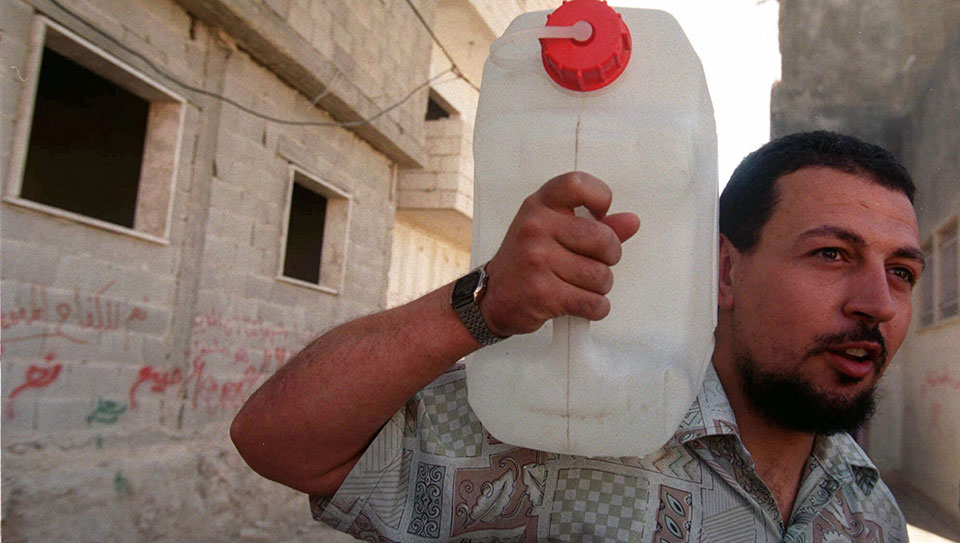
It is written that “Enannatum, ruler of Lagash,” slew “60 soldiers” from Umma. The battle between the two ancient city states took place 4,500 years ago near where the great Tigris and Euphrates rivers come together in what is today Iraq. The matter in dispute? Water.
More than four millennia have passed since the two armies clashed over one city state’s attempt to steal water from another, but while the instruments of war have changed, the issue is much the same: whoever controls the rivers controls the land.
And those rivers are drying up, partly because of overuse and wastage, and partly because climate change has pounded the region with punishing multi-year droughts.

Syria and Iraq are at odds with Turkey over the Tigris-Euphrates. Egypt’s relations with Sudan and Ethiopia over the Nile are tense. Jordan and the Palestinians accuse Israel of plundering river water to irrigate the Negev Desert and hogging most of the three aquifers that underlie the occupied West Bank.
According to satellites that monitor climate, the Tigris-Euphrates Basin, embracing Turkey, Syria, Iraq and western Iran, is losing water faster than any other area in the world, with the exception of Northern India.
The Middle East’s water problems are hardly unique. South Asia—in particular the Indian sub-continent—is also water stressed, and Australia and much of Southern Africa are experiencing severe droughts. Even Europe is struggling with some rivers dropping so low as to hinder shipping.
But the Middle East has been particularly hard hit. According to the Water Stress Index, out of 37 countries in the world facing “extremely high” water distress, 15 are in the Middle East, with Qatar, Kuwait, Bahrain and Saudi Arabia heading the list.
For Syria and Iraq, the problem is Turkey and Ankara’s mania for dam building. Since 1975, Turkish dams have reduced the flow of water to Syria by 40 percent and to Iraq by 80 percent. According to the Iraqi Union of Farming Associations, up to 50 percent of the country’s agricultural land could be deprived of water, removing 124 million acres from production.
Iran and Syria have also built dams that reduce the flow of rivers that feed the Tigris and Euphrates, allowing salt water from the Persian Gulf to infiltrate the Shatt al-Arab waterway where the twin rivers converge. The salt has destroyed rich agricultural land in the south and wiped out much of the huge date farms for which Iraq was famous.
Half a century ago, Israel built the National Water Carrier canal diverting water from the Sea of Galilee, which is fed by the Jordan River. That turned the Jordan downstream of the Galilee into a muddy stream, which Israel prevents the Palestinians from using.
Jordanian and Syrian dams on the river’s tributaries have added to the problem, reducing the flow of the Jordan by 90 percent.
And according to the World Bank, Israel also takes 87 percent of the West Bank aquifers, leaving the Palestinians only 13 percent. The result is that Israelis on the West Bank have access to 240 liters a day per person. Israeli settlers get an extra 60 liters a day, leaving the Palestinians only 75 liters a day. The World Health Organization’s standard is 100 liters a day for each individual.
At 4,184 miles in length, the Nile River is the world’s longest—Brazil disputes the claim—and traverses 10 African countries. It is Egypt’s lifeblood providing both water and rich soil for the country’s agriculture. But a combination of drought and dams has reduced its flow over the past several decades.
Ethiopia is currently building an enormous dam for power and irrigation on the Blue Nile. The source of the Blue Nile is Lake Tana in the Ethiopian highlands. The Egyptian Nile is formed where the Blue Nile and the White Nile—its source is Lake Victoria in Uganda—converge in the Sudan at Khartoum. Relations between Egypt and Ethiopia were initially tense over water but have eased somewhat with the two sides agreeing to talk about how to share it.
But with climate change accelerating, the issue of water—or the lack thereof—is going to get worse, not better, and resolving the problems will take more than bilateral treaties about sharing. And there is hardly agreement about how to proceed.
One strategy has been privatization
Through its International Finance Corporation, the World Bank has been pushing privatizing, arguing that private capital will upgrade systems and guarantee delivery. In practice, however, privatization has generally resulted in poorer quality water at higher prices. Huge transnational companies like SUEZ and Veolia have snapped up resources in the Middle East and global south.
Increasingly, water has become a commodity, either by control of natural sources and distribution, or by cornering the market on bottled water.
Lebanon is a case in point. Historically the country has had sufficient water resources, but it has been added to the list of 33 countries that will face severe water shortages by 2040.
Part of the current crisis is homegrown. Some 60,000 illegal wells siphon off water from the aquifer that underlies the country, and dams have not solved the problem of chronic water shortages, particularly for the 1.6 million people living in the greater Beirut area. Increasingly people have turned to private water sources, especially bottled water.
Multinational corporations, like Nestle, drain water from California and Michigan and sell it in Lebanon. Nestle, though its ownership of Shoat, controls 35 percent of Lebanon’s bottled water. Not only is bottled water expensive, and many times inferior in quality to local water sources, the plastic it necessities adds to a growing pollution problem.
There are solutions
There are solutions out there, but they require a level of cooperation and investment that very few countries currently practice. Many countries simply don’t have the funds to fix or upgrade their water infrastructure. Pipes lose enormous amounts through leakage, and dams reduce river flow, creating salt pollution problems downstream in places like Iraq and Egypt. In any event, dams eventually silt in.
Wells—legal and illegal—are rapidly draining aquifers, forcing farmers and cities to dig deeper and deeper each year. And, many times, those deep wells draw in pollution from the water table that makes the water impossible to drink or use on crops.

Again, there are solutions. California has made headway refilling the vast aquifer that underlies its rich Central Valley by establishing ponds and recharge basins during the rainy season, and letting water percolate back into the ground. Drip agriculture is also an effective way to reduce water usage, but it requires investment beyond the capacity of many countries, let alone small farmers.
Desalinization is also a strategy, but an expensive one that requires burning hydrocarbons, thus pumping more carbon dioxide into the atmosphere and accelerating climate change.
As the Middle East grows dryer and populations in the region continue to increase, the situation will get considerably worse in the coming decades.
The Middle East may be drying up, but so is California, much of the American Southwest, southern Africa, parts of Latin America, and virtually all of southern Europe. Since the crisis is global “beggar thy neighbor” strategies will eventually impoverish all of humanity. The solution lies with the only international organization on the planet, the United Nations.
In 1997, the UN adopted a convention on International Watercourses that spells out procedures for sharing water and resolving disputes. However, several big countries like China and Turkey opposed it, and several others, like India and Pakistan, have abstained. The convention is also entirely voluntary with no enforcement mechanisms like binding arbitration.
It is, however, a start, but whether nations will come together to confront the planet wide crisis is an open question without it, the Middle East will run out of water, but it will hardly be alone. By 2030, according to the UN, four out of 10 people will not have access to water
There is precedent for a solution, one that is at least 4,500 years old. A cuneiform tablet in the Louvre chronicles a water treaty that ended the war between Umma and Lagash. If our distant ancestors could figure it out, it stands to reason we can.










